Overview
The desire to maintain healthy and immature-looking skin is a generally observed thing amongst skincare consumers that extents numerous geographical and generational divides. In today's social media-driven world, and as we enter a new decade marked by the long-term effects of the coronavirus pandemic, people are more conscious than ever about their health, happiness and well-being. With skin being our largest organ and frequently a reflection of inner fermentation caused by stress, lack of sleep, and life factors related to sun exposure, diet, and alcohol consumption.
Herein lies the instigative pledge of cannabinoids as active skincare constituents. Generally speaking, the vast maturity of cannabinoid exploration conducted to date has concentrated on cannabidiol (CBD) and delta-9-tetrahydrocannabinol (THC) as these are the most abundant and readily available cannabinoids produced by the factory species Cannabis SativaL. still, the recent relinquishment of well-established manufacturing styles, videlicet biosynthesis, and chemical conflation, have enabled the marketable vacuity of other cannabinoids such as Cannabigerol (CBG), steering in a new period of cannabinoid exploration and development while contemporaneously creating a dependable force chain defined by high-chastity, harmonious, sustainable and biddable constituents.
Recognizing this opportunity companies have introduced products such as Cellular Goods have engaged in meaningful exploration to understand how these lab-made cannabinoids can enhance skin. The CBG, CBD and their composites can inhibit inflammation and lipid peroxidation caused by UVB radiation, both of which are well- established factors contributing to growing and complaint. By testing on dressed mortal apkins and at commercially applicable cannabinoid attention, these results give material perceptivity into the modality and mileage of cannabinoids to maintain skin health and help signs of growing caused by UV exposure and inflammation.
To know about the cannabidiol (CBD)research study in terms of qualitative and quantitative research on present scenarios, future trends, what are significant drivers that will boost the market demand, what type of challenges will the manufacture fact by, and growth potential for cannabidiol (CBD) skin care market. Kindly visit the below mentioned website links.
As humanity continues to make unprecedented strides in science and medicine, the pursuit of longevity and healthy aging remains an enduring quest. The inevitability of aging, accompanied by a decline in physical and cognitive capabilities, has sparked immense interest in identifying innovative and effective strategies to combat this natural process. In recent years, a groundbreaking area of research has emerged, exploring the potential of cannabinoids in the prevention of aging.
Cannabinoids, the active compounds found in the Cannabis plant, have long been associated with recreational use and medicinal properties. However, more rigorous scientific investigations are uncovering their remarkable therapeutic potential beyond symptom management, particularly when it comes to mitigating the effects of aging on the human body.
This review delves into the emerging landscape of cannabinoid research, with a specific focus on their potential in promoting healthy aging. While the precise mechanisms of action are still being elucidated, early findings suggest that cannabinoids might hold the key to targeting age-related processes at a fundamental level, offering the possibility of extending health span and enhancing overall well-being in our later years.
Aging: A Tale as Old as Time
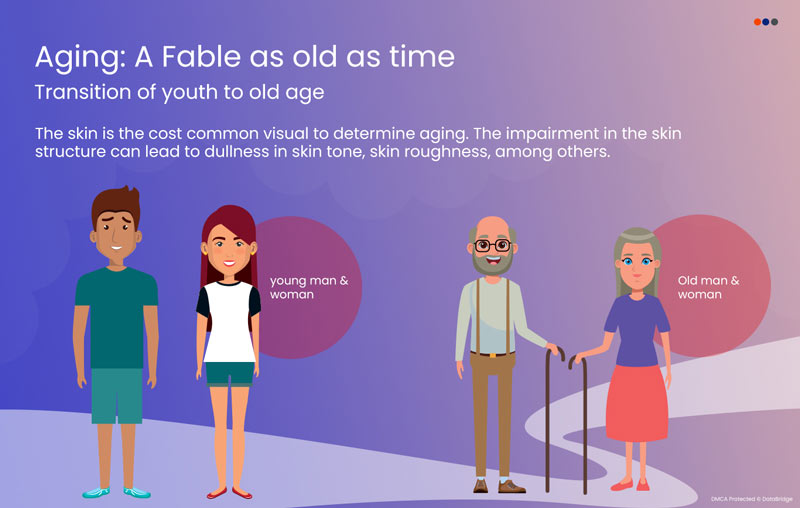
Skin aging is a complex process driven by a range of natural and foreign factors which cumulatively deteriorate the composition, structure, and functioning of the skin. This impairment is responsible for the classical signs of growing skin, which manifest as a loss of skin, uneven and dull skin tone, textural changes leading to an increase in skin roughness, the conformation of fine lines and wrinkles, and skin that becomes teetotaler and more sensitive. As UV exposure is the malefactor behind the utmost visible signs of aging, a robust skincare routine aimed at maintaining skin health and addressing signs of aging should concentrate on mollifying the mischievous goods of UV radiation, including inflammation, lipid peroxidation, and the conformation of reactive oxygen species (ROS).
Awareness and Demand
With signs of growth being a universal concern for skincare consumers, there are consequentially numerous products, procedures, and other strategies that promise to resolve signs of aging and restore an immature appearance. This interest in “anti-aging”, combined with a growing global population and renewed focus on health and heartiness following the COVID-19 epidemic, is anticipated to fuel massive growth.
In keeping with this trend, consumers are decreasingly seeking information on new skincare constituents to help with signs of aging. The most searched constituents in 2020 were vitamin C and retinol, which are extensively regarded as the most effective anti-aging constituents. In 2021 still, L’Oréal Paris USA reported that CBD oil painting was the new top trending component, linking this cannabinoid’s anti-inflammatory parcels to implicit benefits for acne, psoriasis, and eczema
This growing interest in precluding or reversing signs of aging can only be met with the development of innovative constituents with proven efficacy and established safety biographies. Cannabinoids similar to CBG and CBD can meet this need, given their potent antioxidant and anti-seditious parcels which can offset foreign aging caused by UV exposure and inflammation. Their superior tolerability compared to other anti-aging actives, videlicet vitamin C, retinoids, and slipping acids, further positions these unique composites at the van of a new generation of constituents that help signs of aging. In numerous ways, cannabinoids represent the future of growing forestallment and the key to optimizing consumer health and heartiness.
Intrinsic Aging: ATime-Dependent Phenomenon
Natural (or chronological) aging is ineluctable, largely controlled by genetics, and begins following birth8. It's linked to a gradational decline in physiological functioning and the body’s capability to repair the damage that occurs in a cellular position by inflammation, free revolutionaries, complaint, and other degenerative factors. This degeneration is a large focus of the fascinating and ever-growing study of anility, which aims to understand the mechanisms by which cells irreversibly age, stop dividing, and cease normal function.
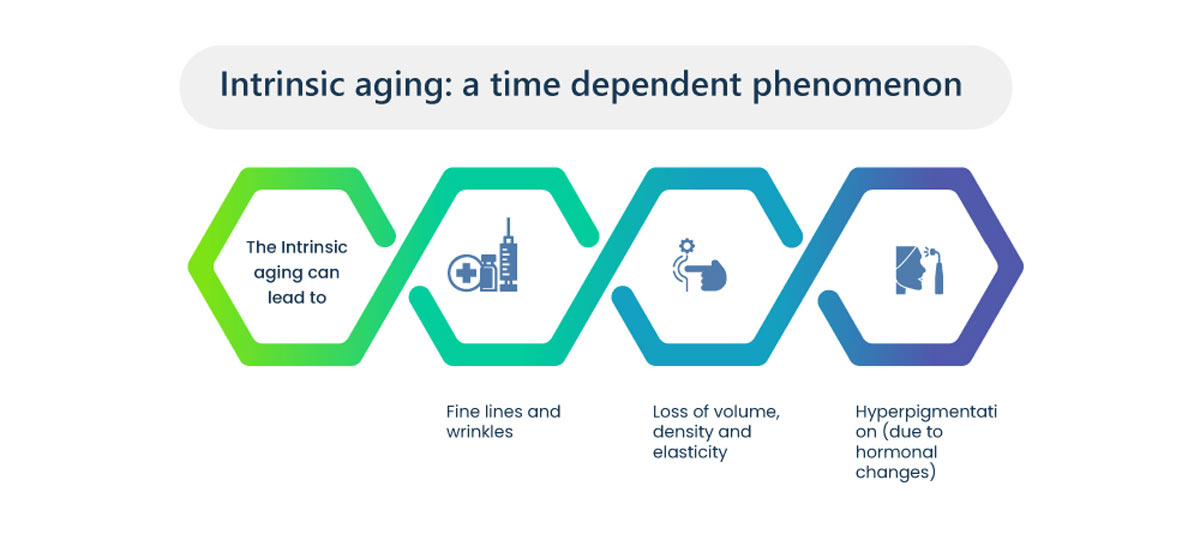
In the context of skin health and appearance, these impaired cellular functions present in several ways:
- A thinning epidermis and dermis along with a reduction in the proliferation (or exchange) of keratinocytes, fibroblasts, and melanocytes between skin compartments impairs the skin’s ability to repair following an injury or trauma
- A decrease in the production, density, and organization of our skin’s essential building blocks, namely collagen, elastin, fibrillin, and proteoglycans, which overtime weakens the extracellular matrix (ECM) leading to a loss in volume, density, and elasticity, and the formation of wrinkles and fine lines
- An uneven distribution and altered activity of melanocytes, result in a paler complexion and uneven skin tone.
- A reduction in sebum production, loss of subcutaneous fat, and decrease in the skin’s lipid content further degrades the skin’s structural integrity and ability to prevent water loss.
Taken together, these intrinsic factors are responsible for classical signs of aging skin, which are characterized as skin that appears thinner, dryer, and less elastic, along with an uneven skin tone and a paler, more translucent complexion.
Extrinsic Aging: the Role of External Aggressors on Skin Health
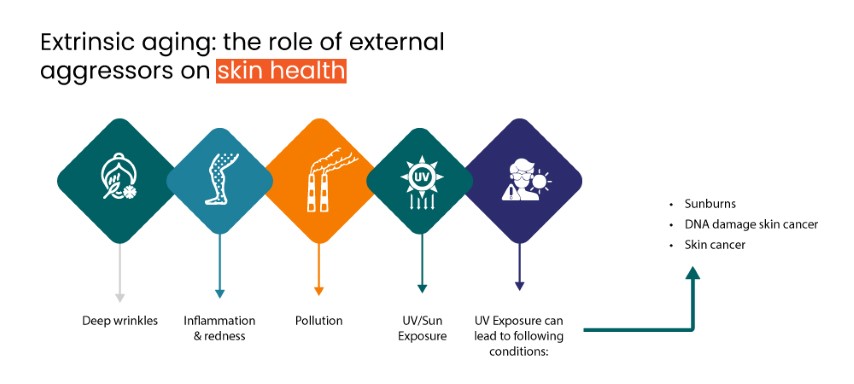
Extrinsic aging is caused by external factors that are frequently linked to life choices. In particular, UV exposure accounts for nearly 80% of growing signs, for which reason UV- convinced foreign aging is occasionally appertained to as photo-aging. Anti-aging skincare results generally revolve around the use of constituents that can offset or proactively alleviate the damage caused by UV exposure, similar to antioxidants and other composites that are able of blocking UV radiation.
Inflammation is another culprit behind extrinsic aging. Inflammation can be caused by a range of external factors, including UV exposure, bacterial pathogens, chemical irritants, and allergens. A growing body of evidence is revealing that the multifaceted effects of inflammation can accumulate over time and accelerate signs of skin aging in a process known as “Inflammageing”.
A robust skincare routine aimed at maintaining skin health and addressing signs of aging should therefore focus on mitigating the detrimental effects of UV exposure and inflammation. However, the selection of active ingredients that are capable of providing these benefits requires a fundamental understanding of the impact these extrinsic factors induce on skin health.
UV Exposure's Negative Impacts
Chronic UV exposure causes a cascade of chemical and physiological alterations that harm the health, functionality, and beauty of human skin. In particular, UV radiation can cause oxidative stress, lipid peroxidation, and glycation, as well as solar elastosis, skin thickening, and oxidative stress and lipid peroxidation, which are two of the main factors contributing to extrinsic aging. Strong anti-inflammatory and antioxidant characteristics are shared by CBG and CBD, which can combat UV-induced aging factors. The tolerance of CBG and CBD is also better than that of vitamin C, retinoids, and exfoliating acids, which are other anti-aging actives.
UV radiation is a form of energy most commonly produced by the sun. Even though there are three types of UV radiation, it is only UVB and UVA that reach the earth’s surface. Having a smaller wavelength, UVB can only penetrate the outer layers of the skin such as the epidermis and is responsible for sunburns and causing earlier signs of photo-aging. UVB radiation can also cause DNA damage, which over time may lead to skin cancer. On the other hand, the longer-wavelength UVA rays are capable of penetrating the deeper skin layers, such as the dermis, causing changes to collagen, elastin, and also DNA. As UV radiation can travel through clouds and reflect off surfaces such as snow, water, sand and grass, UV exposure is essentially a guarantee of life on earth.
Inflammageing
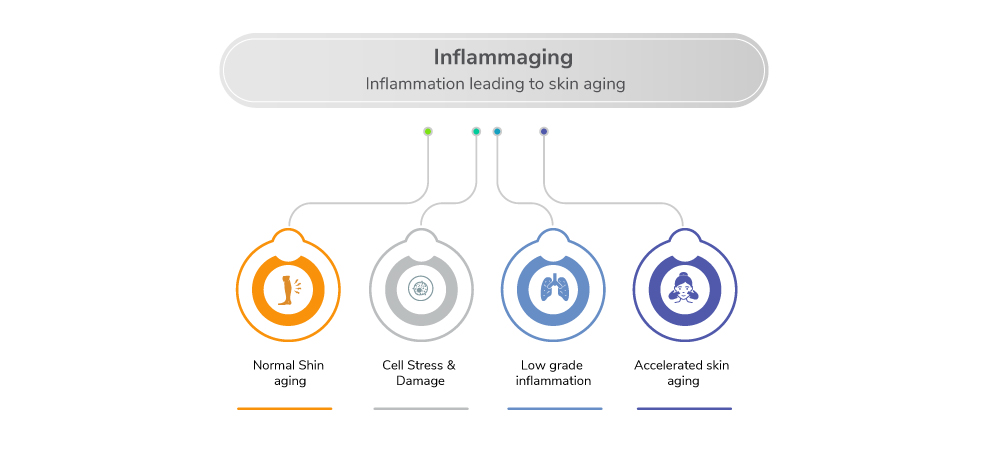
Inflammation is part of our body's natural immune response and serves as an essential defense mechanism to protect against injury and infection caused by a range of aggressors, including pathogens, toxic compounds, damaged cells, allergens, and radiation. While inflammation is also an essential part of the healing process, chronic inflammation can create a persistent and exhaustive state of chaos for the body.
There is a growing body of evidence which indicates that chronic inflammation can accelerate cellular aging. This process has recently been coined with the term “inflammaging”. Inflammaging generally involves cumulative tissue damage that can lead to a range of diseases, such as diabetes, atherosclerosis, macular degeneration, and skin aging, suggesting that inflammation is a major determinant of overall health and wellness
In the context of skincare, acute inflammation may cause redness and sensitivity while also compromising the integrity of our skin barrier. With skin being the body’s largest and most critical organ responsible for keeping foreign and potentially harmful invaders out, a compromised skin barrier is a slippery slope to experiencing other issues such as dryness, blemishes, and other infections.
UV exposure triggers a series of inflammatory events involving the release of ROS, inflammatory mediators such as tumor necrosis factor-alpha (TNF-α), interleukin-1 (IL-1), interleukin-6 (IL-6), and interleukin-8 (IL-8), alongside MMPs which induce their own localized destructive effects. Interestingly, UV exposure also induces the activation of macrophages and neutrophils which have been shown to infiltrate into the epidermis to remove cellular debris and other cells affected by UV exposure. This suggests that inflammaging and photoaging are intertwined with an innate immune response.
Cosmetic Solutions for Aging Prevention
The two kinds of anti-aging techniques are proactive and reactive, with the former focusing on preventing damage from external aggressors and the latter on repairing already-occurring damage to the skin. Unfortunately, there is no "one size fits all" treatment for aging skin, thus a combined strategy is frequently the most successful. Retinoids, exfoliating acids, and vitamin C have often been used by the cosmetic industry to reverse indications of aging, but they can also irritate skin and increase photosensitivity. Ingredients that are just as effective as those now used in the business but are also more tolerable are required.
Given that UV exposure is the primary cause of extrinsic aging, the best method for reducing skin damage is the use of sunscreens and other products with verified Sun Protection Factors (SPF). Dermatologists advise using products with broad-spectrum protection to guard against UVA and UVB radiation as SPF is a measure of UVB protection. Using topical antioxidants, such as vitamin C, to scavenge radicals produced by actual sun exposure is a supplementary strategy.
However, the use of sunscreens and antioxidants does not provide complete protection against photoaging, and they are not solutions to combat the signs of aging caused by internal factors such as hormonal changes and genetic factors. Fortunately, there are more and more ingredients that help keep skin healthy by mitigating the degenerative effects of existing skin damage and the internal aging process.
In the past, this list included ingredients such as retinoids, exfoliating acids, glycolic, and lactic acids. In recent years, vitamin C and peptides (such as matrikines) have also been found to be effective in reversing the signs of aging skin. These ingredients offer a variety of anti-aging properties, but the most common mechanisms of action are promoting collagen synthesis and promoting cellular turnover. Matrikines are peptide chains that are made from fragments of the ECM proteins such as collagen, elastin that regulate a variety of cellular functions associated with growth and repair.
Regardless of the limitations, many consumers trudge onwards with using popular exfoliating acid, vitamin C, and retinoid for the sake of healthy and youthful-looking skin. The adoption of retinoids and exfoliating acids is often a slow and painful process. In the case of retinoids, consumers are advised to “start low and go slow” while also avoiding the simultaneous use of other skincare ingredients with irritation potential (such as vitamin C). It can often take several weeks for the skin to adjust to new retinoid-based products, during which time erythema, dryness, and flaking may occur.
The guidance on exfoliating acids is somewhat similar to retinoids in that consumers are advised to limit their use of exfoliating acids to a few times a week while alternating the use of these products with other irritating ingredients and avoiding sun exposure. Products intended for at-home use generally contain between 5 to 20 % acids, while in-clinic treatments such as chemical peels contain much higher concentrations.
In the case of vitamin C, the minimum effective concentration for desired aging-related outcomes is 8%. However, many products contain upwards of 10%, furthering the risk of irritation as a trial-and-error approach may be required to identify products containing a tolerable yet effective concentration, particularly amongst consumers with sensitive skin or those who are using products containing retinoids and exfoliating acids.
These limitations point to the need for non-irritating ingredients with multifaceted benefits that can address the many harmful aging effects of UV exposure and inflammation. Cannabinoids can effectively fill this gap given their established anti-inflammatory and antioxidant properties, presenting a new frontier for active aging prevention solutions.
Cannabinoids as Multifaceted Aging Prevention Actives
Cannabinoids are fascinating molecules with immense promise in the context of health, wellness and aging. Most notably, cannabinoids such as Cannabigerol (CBG) and Cannabidiol (CBD) have been shown to counteract the inflammatory effects of UVA, UVB bacterial pathogens and chemical irritants, while also possessing the superior antioxidant capacity to ascorbic acid (vitamin C) and the ability to inhibit lipid peroxidation caused by UVB exposure. These combined properties open the door to an entirely new range of active skincare solutions that, unlike traditional treatments, do not pose risks for irritation and photosensitivity.
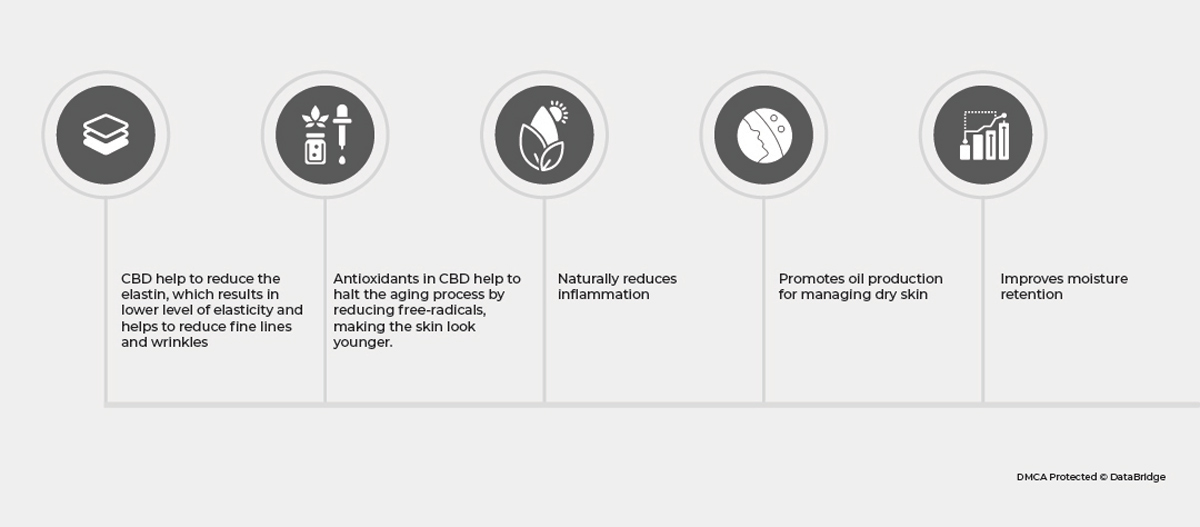
Challenges Associated With Cannabidiol (CBD) for Skin Care and Anti-Aging
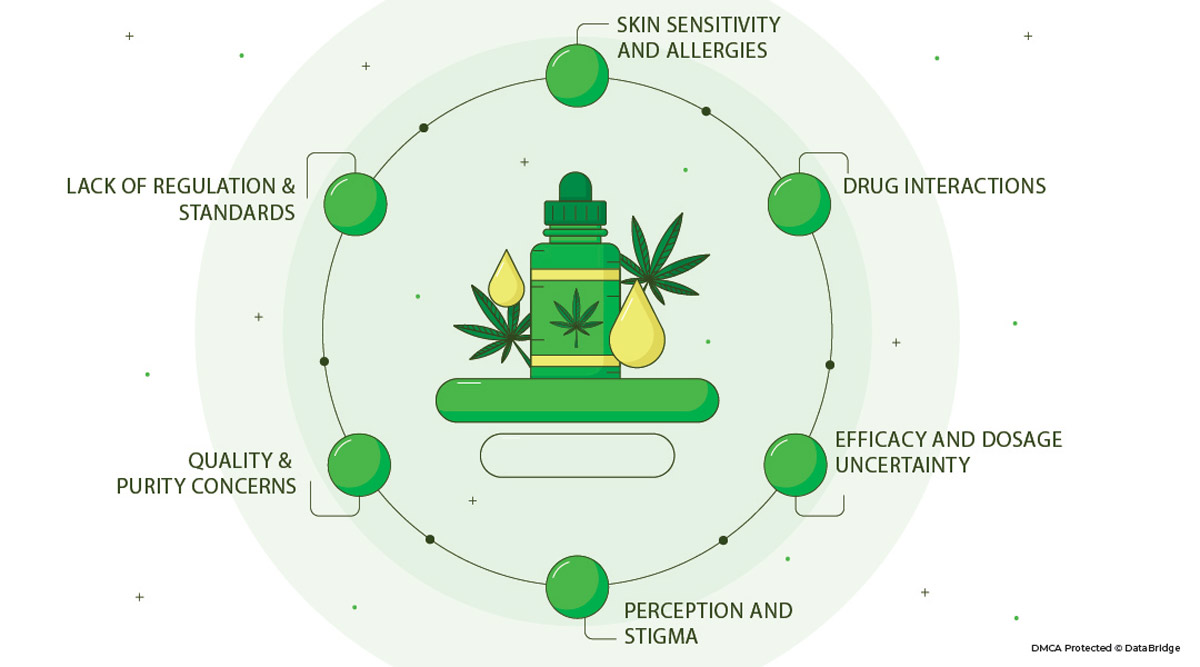
The integration of Cannabidiol (CBD) into the realm of skincare has garnered significant attention in recent years, with numerous products touting its potential benefits. While CBD shows promise for various skin conditions and overall skin health, its incorporation into skincare products also brings about several challenges that need to be carefully addressed. These challenges include:
- Lack of Regulation and Standards: The CBD skincare industry is still relatively new and lacks comprehensive regulation and standardized guidelines. As a result, consumers may encounter a wide variety of products with inconsistent CBD concentrations, impurities, or even misleading claims. This lack of oversight poses potential risks to consumers who may unwittingly use substandard product
- Quality and Purity Concerns: The sourcing and extraction methods of CBD can significantly impact its quality and purity. Depending on the origin of the hemp plant and the extraction process used, CBD products may contain impurities, residual solvents, or other cannabinoids like THC (tetrahydrocannabinol) beyond permissible limits. Ensuring high-quality and pure CBD is essential to minimize adverse reactions and maximize its benefits.
- Skin Sensitivity and Allergies: While CBD is generally considered safe, some individuals may experience skin sensitivity or allergic reactions to topical CBD products. Just like any other skincare ingredient, it is essential for users to conduct patch tests before full application to determine if they have any adverse reactions to CBD
- Drug Interactions: CBD can interact with certain medications, especially those metabolized by the liver's cytochrome P450 enzyme system. When applied topically, the risk of drug interactions is lower compared to ingesting CBD, but it still exists. Individuals using medications should consult with a healthcare professional before using CBD skincare products to avoid potential complications
- Efficacy and Dosage Uncertainty: Research on CBD's specific benefits for various skin conditions is still in its early stages. While there is some evidence supporting CBD's anti-inflammatory and antioxidant properties, its efficacy and optimal dosage for specific skin concerns remain unclear. Determining the right concentration of CBD in skincare products to achieve desired effects can be challenging without more robust scientific data
- Stability and Shelf Life: CBD, like many other active compounds, can be sensitive to light, heat, and air exposure, which may compromise its stability and potency over time. Ensuring adequate product stability and shelf life is vital to maintain the efficacy of CBD skincare formulations
- Perception and Stigma: Despite the growing acceptance of CBD in various industries, there may still be lingering stigma surrounding cannabis-related products. Some consumers may be hesitant to use CBD skincare products due to misconceptions or concerns about potential legal issues, especially if the products contain traces of THC
To address these challenges, the CBD skincare industry must prioritize research, adhere to quality standards, and educate consumers about the potential benefits and risks of using CBD for skincare. As scientific knowledge expands, and regulations evolve, the potential of CBD as a valuable skincare ingredient may be harnessed more effectively and safely.
What Consumers Need to Know and how does it affect the Consumers?
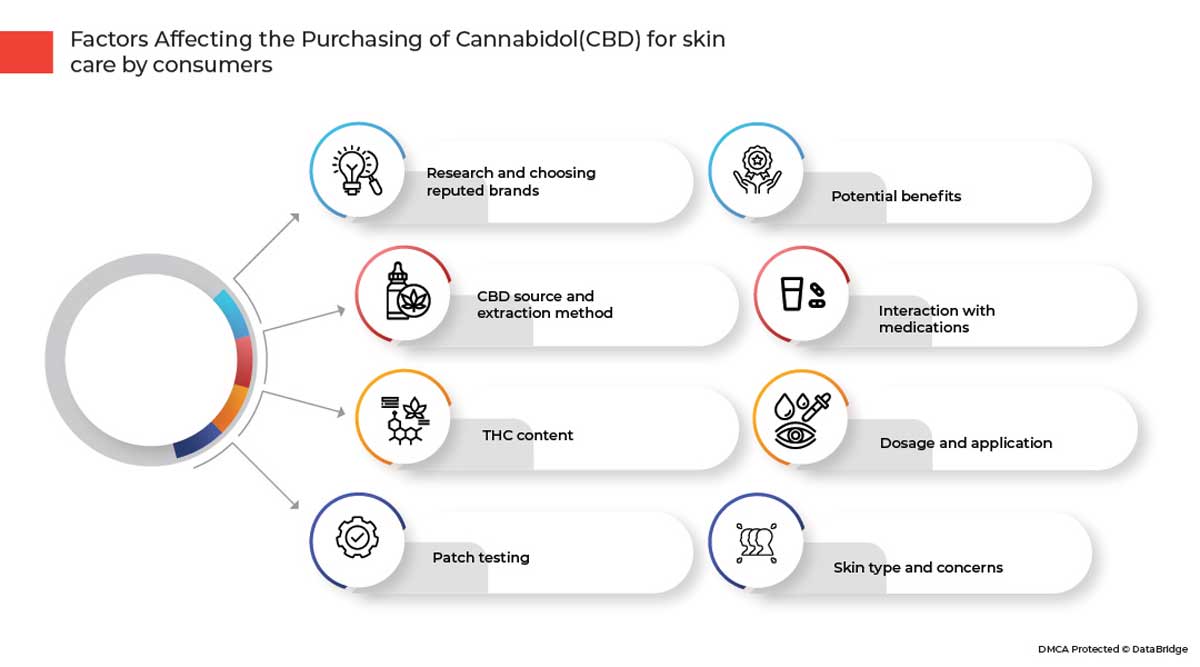
Consumers considering CBD products for anti-aging and skincare should be well informed to make safe and effective choices. Here are essential factors that consumers need to know:
- Research and Choose Reputable Brands: Due to the lack of stringent regulations in the CBD industry, it's essential to research and choose reputable brands that prioritize quality, safety, and transparency. Look for companies that provide third-party lab test results for their products, verifying CBD content, purity, and the absence of contaminants.
- CBD Source and Extraction Method: Understanding the source of CBD is crucial. Look for products derived from high-quality hemp plants grown in well-regulated and organic environments to minimize exposure to harmful chemicals. Additionally, inquire about the extraction method used, as reputable brands employ safe and efficient methods like CO2 extraction to obtain pure CBD.
- THC Content: While CBD products are typically required to contain less than 0.3% THC to be legally sold in many regions, some may still contain trace amounts of THC. Consumers should be aware of the THC content in their CBD skincare products, especially if they are sensitive to THC or subject to drug testing
- Patch Testing: Before applying CBD skincare products to a larger area, perform a patch test on a small section of your skin. This helps identify any potential allergic reactions or skin sensitivities to CBD or other ingredients in the product
- Potential Benefits: While CBD's anti-aging and skincare benefits are promising, the scientific evidence is still developing. Understand that individual results may vary, and CBD may not work the same way for everyone. Be cautious of extravagant claims and unrealistic promises from brands
- Consistency and Patience: Skincare products, including those with CBD, often require consistent use over time to achieve noticeable results. Don't expect immediate changes, and be patient as you incorporate CBD products into your skincare routine
- Interaction with Medications: If you are using medications, consult with a healthcare professional before using CBD skincare products, as CBD may interact with certain medications, especially when ingested orally
- Sunscreen: CBD skincare products do not replace the need for sunscreen. Sunscreen remains essential for protecting your skin from harmful UV rays and preventing premature aging
- Dosage and Application: Follow the manufacturer's recommended dosage and application instructions for the specific CBD skincare product you are using. Avoid overusing or misusing the product
- Skin Type and Concerns: Consider your skin type and specific concerns when selecting CBD skincare products. Some products may be more suitable for certain skin types or targeted concerns, such as dryness, acne, or inflammation
- Personal Health Conditions: If you have specific skin conditions or health concerns, consult with a dermatologist or healthcare professional before using CBD products for anti-aging or skincare purposes
By being informed about these essential aspects of CBD skincare products, consumers can make educated choices that align with their skincare goals and prioritize their safety and well-being.
Company’s Uptake on CBD Skin Care and Beauty Products
The growing awareness of the benefits of CBD-infused personal care products is expected to create demand for the market during the forecast period.
For instance,
- In November 2022, entrepreneurs Yann Moujawaz and Juana Martini launched their CBD-based skincare brand - Juana Skin in the U.AE. In addition, the healing properties of these ingredients are expected to encourage manufacturers to develop products infused with the benefits of CBD
- In February 2020, Sephora launched a special section solely dedicated to CBD skin care products in its stores, and Ulta Beauty is also planning to dedicate a special section for such products in the coming years
CBD-based skin care products offer various benefits such as improved sleep and help in the treatment of various skin conditions such as eczema and psoriasis, as well as acne. The unique benefits associated with CBD-based skin care have been capitalized on by cosmetic companies, who are promoting CBD-infused skin care products as “natural cosmetics” in the market. The multi-functional attributes of these products are expected to propel the demand for CBD skin care products
The sale of American-produced hemp-based personal care products has doubled owing to the acceptance of multi-channel distribution by wholesalers, private labelers, and other importers. These stakeholders are developing a separate product line of CBD-infused personal care products, which comprises skin care, hand care, and lip moisturizer products. Companies are primarily marketing their products for health benefits associated with CBD in skin care products.
Conclusion
Skin aging is an inevitable process driven by a range of factors dominated by UV exposure and chronic inflammation. Solutions aimed at preventing signs of aging should therefore directly address the deleterious impacts of these aggressors by reducing inflammation and preventing lipid peroxidation and further damage caused by reactive oxygen species, all of which lead to degradation of the extracellular matrix, a loss of elasticity, the formation of fine lines and wrinkles, a dull and uneven skin tone, and dry skin.
While the current catalog of aging prevention ingredients, namely vitamin C, retinoids, and exfoliating acids, can provide some protection against photo- and inflammaging while imparting other aging benefits by way of collagen synthesis, their use is often limited due to their irritancy potential and photosensitivity. This points to the need for well-tolerated active ingredients that can proactively mitigate UV and inflammation-induced damage responsible for signs of aging.
To this end, cannabinoids such as CBG and CBD are well-positioned to fill this gap due to their potent anti-inflammatory and antioxidant properties. Scientific research has revealed that CBG and CBD are capable of preventing inflammation caused by UVA and UVB exposure equally if not more effectively than vitamin C. These cannabinoids and their blends can also prevent lipid peroxidation caused by UVB exposure, which is a significant feat considering their improved tolerability compared to vitamin C.
Taken together, these results indicate that cannabinoids are compelling ingredients that provide multiple mechanisms against photo- and inflammaging, qualifying them as novel ingredients with immense potential for aging prevention solutions. Cellular Goods is one of the companies to offer science-backed skincare solutions that leverage the potent anti-inflammatory and antioxidant properties of high- purity lab-made cannabinoids to provide consumers with targeted solutions for aging prevention.









